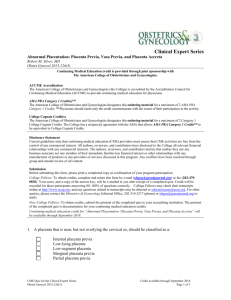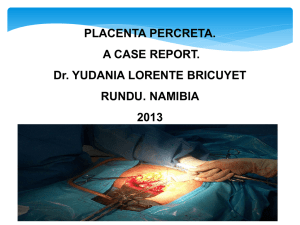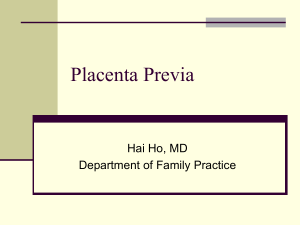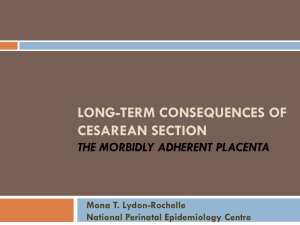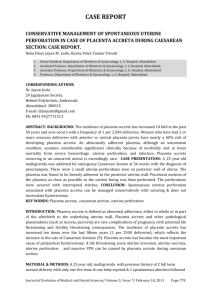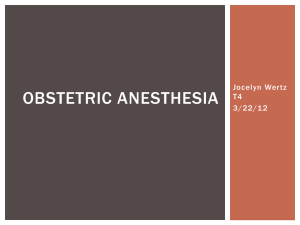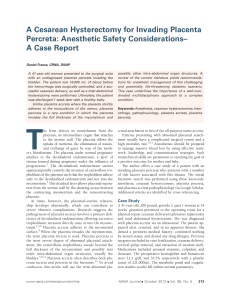Placenta accreta - UC San Diego Health Sciences
advertisement
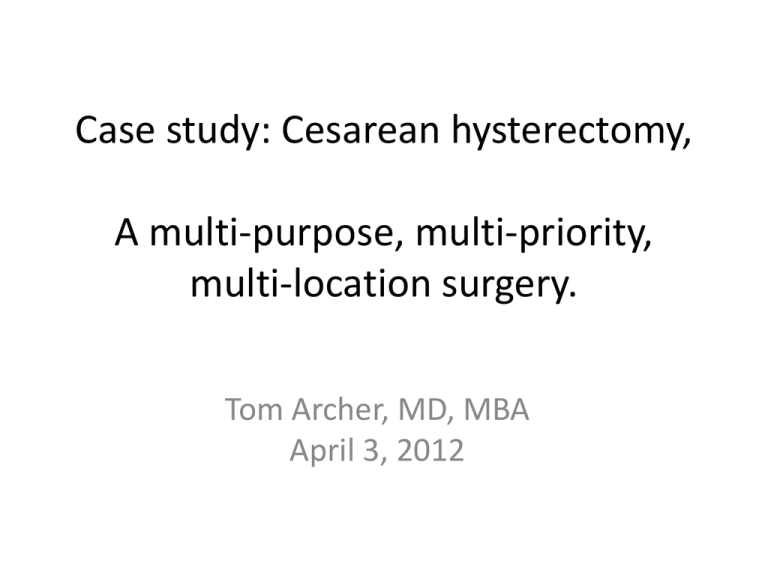
Case study: Cesarean hysterectomy, A multi-purpose, multi-priority, multi-location surgery. Tom Archer, MD, MBA April 3, 2012 Cesarean hysterectomy for placenta accreta • Growing problem because of high CS rate. • Prior CS creates low anterior uterine scar implantation of next pregnancy in scar low lying, invasive placenta which easily grows across the cervical os Placenta previa + accreta. Figure 1 Placenta previa in a patient with a previous C-section should raise suspicion of placenta accreta, which will necessitate Cesarean hysterectomy. 1st C-section 2nd pregnancy implants in scar Placenta previa and accreta “Low transverse” incision in uterus above bladder creates scar after first C-section. Scar serves as a low implantation site for second pregnancy. Low-lying placenta grows over cervical os, forming placenta previa, and grows deeply into uterine scar, becoming accreta (percreta with bladder invasion shown here). Placenta accreta: 1) Usually occurs in previous CS scar (low and above bladder). 2) Placenta invades deeply within scar (becomes “accreta”) 3) Placenta starts low (growing over cervical os, becoming “previa”) 4) Placenta previa + (multiple) previous CS high likelihood of accreta 5) Commonest organ for invasion by the placenta accreta is the bladder 6) Diagnosis by US or MRI. Placenta accreta– abnormally adherent placenta DOES NOT COME OUT AFTER DELIVERY. Patient bleeds because uterus CANNOT CONTRACT WITH PLACENTA INSIDE. Nursingcrib.com Placenta accreta with bladder invasion (MRI scan) Cesarean Hysterectomy • C-section followed by hysterectomy. • Most OBs have limited experience with this. • Uterus is highly vascular and bleeding is rapid. • Extensive planning is extremely important. Possible adjuncts to care of placenta accreta patient • Internal iliac balloons to temporarily reduce bleeding. Placed in Interventional radiology. --31-year-old woman with placenta percreta Tan, C. H. et al. Am. J. Roentgenol. 2007;189:1158-1163 Copyright © 2008 by the American Roentgen Ray Society Possible adjuncts to care of placenta accreta patient • Cell saver– OK despite fears of “amniotic fluid embolus”. Use after amniotic fluid is gone. AFE probably not due to AFE. “Anaphylactoid syndrome of pregnancy.” • Level 1 or other rapid infusion system Possible adjuncts to care of placenta accreta patient • Acute normovolemic hemodilution. Cardiac output 10 Figure 2 0 Systemic vascular resistance 2000 0 Blood pressure 150 0 Heart rate and stroke volume Heart rate 100 0 0 15 Start ANH 30 min 60 End ANH Ind/Inc Del Old “procedure” for C-hyst • “Night” OB anesthesia team would “place epidural” and ? “arterial line” so that patient could go to IR at “0530” for “0700 OR start”. Day anesthesia team would take patient over from night anesthesia team. • Profound disadvantages: fragmentation of care AND absence of full complement of daytime resources. Starting major elective procedure outside of elective OR time BAD IDEA! Any complicated surgery • Intersection of: medical, technical, organizational and interpersonal factors. • Successful MD or nurse must take all of these aspects into account. • Don’t underestimate the problems that can arise with a complicated, multi-site surgery! • COMMUNICATE! Cesarean hysterectomy • Fraught with dangers (medical, psychological, political). • Be aware of this. Don’t fight it. Consult in advance with all parties. Acknowledge points of view, but… • Remember that ultimate responsibility for anesthesia rests with us. Try to say this nicely. Multiple voices will be heard • Patient preference (GA or epidural) • Surgeon preference (GA or epidural) • “Baby-friendly” advocates may promote maternal bonding with infant. • Listen carefully to all opinions, but ultimate decision is yours. You are responsible for anesthesia Cesarean hysterectomy • In your discussions, acknowledge points of view, but PRIORITIZE: • “Yes, it would be great if you could be awake for the birth, but Dr. X thinks that in your case the bleeding may be more than usual and for this reason we want to do the general anesthetic because…..” Multiple voices will be heard • My advice: consult early, abundantly and respectfully. • Explain your decision to all concerned. Assume that there will be poor communications, rumors, misinformation. • Straight GA is sometimes the best answer in an accreta with extensive invasion. Current approach • If you do epidural, must be before balloon placement in IR (patient hip flexion impossible after balloon placement). • If you do epidural and dose it for balloon placement, you must go to IR with patient. • At least two “large bore” IVs. • Arterial line (awake) • Possible Cordis sheath (awake) Current approach • Emotional support for Mom– extensive, frightening and painful preparation before what should be a happy event. • Judicious use of fentanyl, midazolam for line placement. • Once patient is asleep there is no time for Cordis placement before baby is delivered and hemorrhage occurs. Factors favoring epidural: Analgesia for balloon placement in interventional radiology suite (but local is easy too) Surgical anesthesia (hopefully it works well enough). Patient awake for birth Post-op pain control (epidural morphine) Factors opposing epidural: Need to monitor patient and fetus in multiple locations (Epidural placed in L&D, then IR, then OR). Sympathectomy is dangerous in setting of heavy blood loss. May not be adequate anesthesia for hysterectomy. Psychological factors (long surgery, awake patient with heavy bleeding, transfusion, hypotension-- caregiver and patient stress). Unprotected airway during big/long surgery. Straight GA Pro: simple, straightforward, one anesthetic, avoids sympathectomy and psychological issues. Con: Patient asleep for birth, pushback from “patient advocates”. Inferior pain control postop compared to epidural. Baby may be born “depressed” (by GA). If you use GA • Make sure everyone understands that baby “depressed” by GA is NOT SICK or HYPOXIC. • As much as we may understand this, nonanesthesia people will associate “depressed” baby with hypoxia and damage and will worry a great deal about this. Cesarean hysterectomy Current Policy • One anesthesia team will do all physical preparation of the patient, starting at the designated start time. No “line placement” by the “night team”. • Purely informational consults are performed as early as possible and someone from the OB anesthesia team should do this when possible. Cesarean hysterectomy Current Policy • There is no “standard” anesthetic. • The choice of anesthesia is up to the attending anesthesiologist for the case, after consultation with patient and surgeons. The (current) “solution” came from several interdisciplinary conferences. • OR management (MDs and nursing) made “0730 start” available to OBs, even though OR may not be physically used until 0900-1000, due to patient preparation in IR. Agreement to let room sit unused. • One anesthesia team starts at 0700 with ALL of the physical preparation of the patient: epidural (if used), go to IR (if used), arterial line and IV access (Cordis sheath vs. mult PIV) Advantages of The (current) “solution” • Only one anesthesia team provides continuity of care and responsibility re: – Epidural (does it really work?), What happened in IR, Patient emotional state, Presence of father of baby in OR, Communication with OB team OBs have guaranteed OR once patient is done in IR Summary • C-hyst: increasing CS rate is creating the iatrogenic problem of placenta previa and accreta in subsequent pregnancies. • Placenta accreta: potentially fatal due to torrential hemorrhage. • Extensive multidisciplinary planning and discussion is required to do these cases well.
